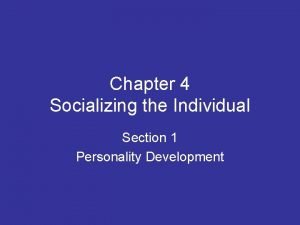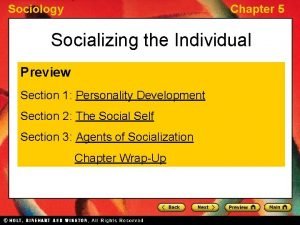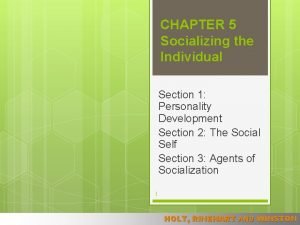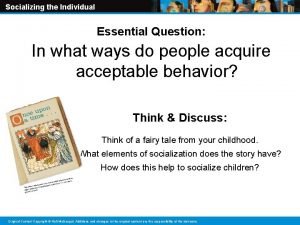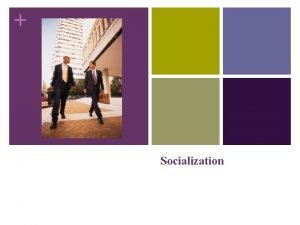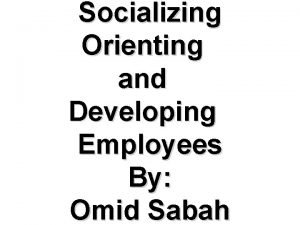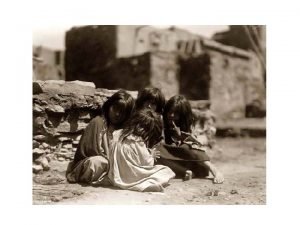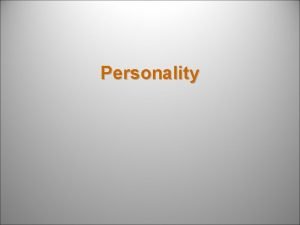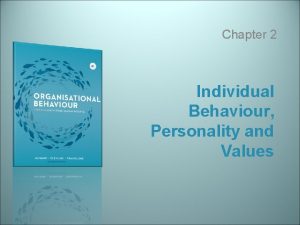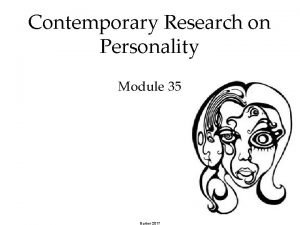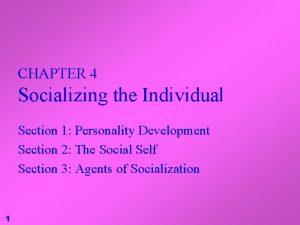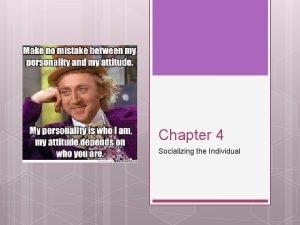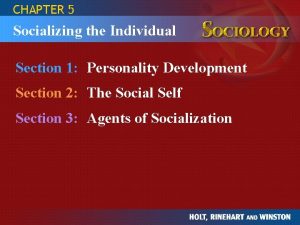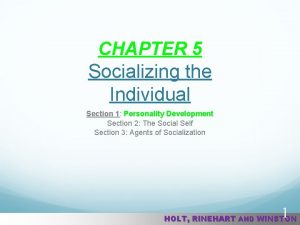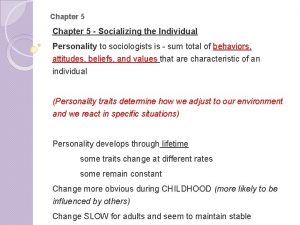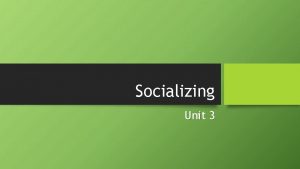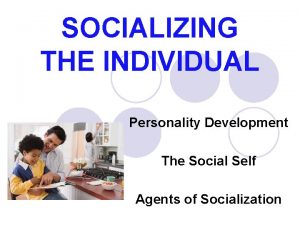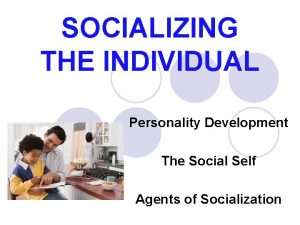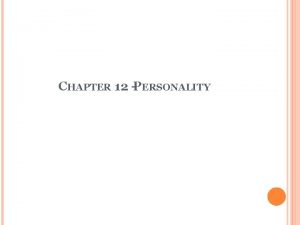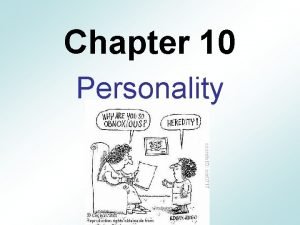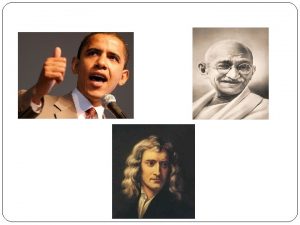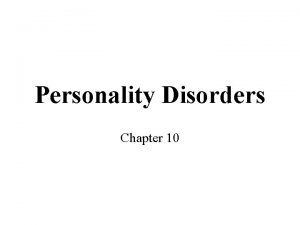CHAPTER 4 Socializing the Individual Section 1 Personality

































- Slides: 33

CHAPTER 4 Socializing the Individual Section 1: Personality Development Section 2: The Social Self Section 3: Agents of Socialization 1 HOLT, RINEHART AND WINSTON

Would you be “you” if you were isolated from birth?

Then how do “you” become “you”?

Socialization lifelong social experience by which people develop their human potential & learn culture

5 Section 1: Personality Development Objectives: Identify the four main factors that affect the development of personality. Explain how isolation in childhood affects development.

6 Section 1: Personality Development Factors That Shape Personality Development Heredity – physical traits, aptitudes, inherited characteristics, biological drives

7 Section 1: Personality Development Factors That Shape Personality Development Parents – parental characteristics, such as age, education, religion, & economic status

8 Section 1: Personality Development Factors That Shape Personality Development Birth order – personalities are shaped by whether one has siblings

9 Section 1: Personality Development Factors That Shape Personality Development Cultural environment – determines the basic personality types found in a society

10 Section 1: Personality Development Isolation in Childhood and Development Research shows a healthy cultural environment essential for child’s full development Isolation can lead to severe effects such as causing children to waste away & die, or to have stunted development

11 Section 2: The Social Self Objectives: Explain how a person’s sense of self emerges. Identify & describe theories that attempt to explain the process of socialization.

12 Section 2: The Social Self How Sense of Self Emerges Through interaction with social & cultural environments people are transformed into members of society The interactive process through which people learn basic skills, values, beliefs, & behavior patterns of a society = socialization

13 Section 2: The Social Self Three Theories of Socialization John Locke – The Tabula Rosa Charles Horton Cooley – The Looking Glass Self George Herbert Mead – Role-Taking

14 Section 2: The Social Self John Locke – The Tabula Rosa blank slate at birth; no personality develop personality as a result of social experiences infants can be molded into any type of person

15 Section 2: The Social Self Charles Horton Cooley – The Looking Glass Self Infants have no sense of person or place. Children develop an image of themselves based on how others see them. People act as a mirror, reflecting back the image a child projects through their reactions to the child’s behavior.

“I” “Me” Reflect on how it’s Initiate the action perceived The subject part of ourself, active & spontaneous The objective side, we think of ourselves as other see us

18 Section 2: The Social Self George Herbert Mead – Role-Taking People not only come to see themselves as others see them, but also take on, or pretend to take on, the roles of others through imitation, play, and games. enables people to anticipate what others expect of them.

19 Section 3: Agents of Socialization Objectives: Identify the most important agents of socialization in the United States. Explain why family and education are important social institutions. Family School Language acquisition, relationships, rules, initial social interactions, morals, role models, behaviour Grammar Rules Social setting values Peers Activities trends Religion Values, love for others, meaning of life, Guidelines on how to live Clubs/ Social Groups Social interaction rules governing activites Agents of Socialization Ethnic Background Beliefs Values Customs Work Employment Money Rules Roles Media Stereotypes Trends How to act Government Laws, sense of security, Sanctions of punishment

20 Section 3: Agents of Socialization Family – the most important agent

21 Family Loving family produces happy well-adjusted child Parental attention is very important bonding & encouragement Household environment stimulates development Social position race, religion, ethnicity, class

23 Section 3: Agents of Socialization Peer group primary group composed of individuals of roughly equal age & social characteristics particularly influential during preteenage & early teenage years

Peer Groups Developing sense of self - goes beyond family Young & old attitudes - “generation gap” Peers often govern short-term plans while parents influence long-term goals. Anticipatory socialization Practice toward gaining desired positions

25 Section 3: Agents of Socialization School – plays a major role

26 School Experience Racial & gender clustering Hidden curriculum Informal, First diversity covert lessons bureaucracy Rules & schedule Gender socialization begins Gender-linked activities from grade school through college

27 Section 3: Agents of Socialization Importance of Family and Education Teach life skills Teach values, norms & beliefs

Section 3: Agents of Socialization Mass media – books, films, Internet, magazines, TV; not face-to-face

Mass Media TV in the USA 98% of households have at least 1 2/3 households have cable or satellite Hours of viewing Average Almost Children TV, household = 7 hours per day ½ an individuals’ free time average 5 ½ hours per day. videotapes, video games

What do we learn here?

And then there are commercials & ads. What do we learn here?

Criticisms About Programming • • • concerns regarding race & gender inequality conservative concerns about advancing liberal causes– “politically correct” Violence in mass media A 1998 survey: 2/3 of TV programming contains violence characters show no remorse characters aren’t punished In 1997, the television industry adopted a rating system.

33


CHAPTER 4 Socializing the Individual Section 1: Personality Development Section 2: The Social Self Section 3: Agents of Socialization 35 HOLT, RINEHART AND WINSTON
 Socializing the individual section 1
Socializing the individual section 1 Socializing the individual section 3
Socializing the individual section 3 Sociology chapter 5 socializing the individual
Sociology chapter 5 socializing the individual Socializing the individual review worksheet
Socializing the individual review worksheet 6 agents of socialization
6 agents of socialization Socializing orienting and developing employees
Socializing orienting and developing employees Socialization synonym
Socialization synonym An individual's personality is the sum of their
An individual's personality is the sum of their Types of individual behavior
Types of individual behavior Judy believes that her fate is determined
Judy believes that her fate is determined Section quick check chapter 10 section 1 meiosis answer key
Section quick check chapter 10 section 1 meiosis answer key Hát kết hợp bộ gõ cơ thể
Hát kết hợp bộ gõ cơ thể Bổ thể
Bổ thể Tỉ lệ cơ thể trẻ em
Tỉ lệ cơ thể trẻ em Chó sói
Chó sói Tư thế worm breton
Tư thế worm breton Hát lên người ơi alleluia
Hát lên người ơi alleluia Các môn thể thao bắt đầu bằng từ đua
Các môn thể thao bắt đầu bằng từ đua Thế nào là hệ số cao nhất
Thế nào là hệ số cao nhất Các châu lục và đại dương trên thế giới
Các châu lục và đại dương trên thế giới Công thức tiính động năng
Công thức tiính động năng Trời xanh đây là của chúng ta thể thơ
Trời xanh đây là của chúng ta thể thơ Mật thư anh em như thể tay chân
Mật thư anh em như thể tay chân 101012 bằng
101012 bằng Phản ứng thế ankan
Phản ứng thế ankan Các châu lục và đại dương trên thế giới
Các châu lục và đại dương trên thế giới Thể thơ truyền thống
Thể thơ truyền thống Quá trình desamine hóa có thể tạo ra
Quá trình desamine hóa có thể tạo ra Một số thể thơ truyền thống
Một số thể thơ truyền thống Cái miệng bé xinh thế chỉ nói điều hay thôi
Cái miệng bé xinh thế chỉ nói điều hay thôi Vẽ hình chiếu vuông góc của vật thể sau
Vẽ hình chiếu vuông góc của vật thể sau Nguyên nhân của sự mỏi cơ sinh 8
Nguyên nhân của sự mỏi cơ sinh 8 đặc điểm cơ thể của người tối cổ
đặc điểm cơ thể của người tối cổ
